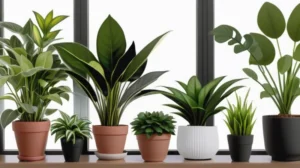Radiation and electromagnetic fields (EMF) are common concerns in our modern lives. With the increasing use of electronic devices and exposure to various radiation sources, people are looking for effective ways to mitigate the potential harmful effects. One intriguing approach is the use of plants that can absorb radiation and EMF. In this article, we will explore the world of these remarkable plants and discover their unique abilities to absorb these invisible threats.
Understanding Radiation and EMF
Radiation is the emission of energy as electromagnetic waves or as moving subatomic particles. It can come from various sources, including natural occurrences like cosmic rays or human-made technologies such as X-ray machines and nuclear power plants. On the other hand, EMF refers to the invisible fields of energy produced by electrically charged objects, such as power lines, appliances, and wireless devices.
Plants That Absorb Radiation
Using plants to absorb radiation has gained attention due to their ability to naturally remove toxins from the air and soil. These plants act as biological filters and can help reduce the presence of harmful radiation in their surroundings. Additionally, they provide a cost-effective and environmentally friendly solution. Some effective plants for radiation absorption include:
- Aloe vera (Aloe barbadensis): This succulent plant not only absorbs radiation but also releases oxygen, improving the overall air quality.
- Spider plant (Chlorophytum comosum): Known for its air-purifying qualities, the spider plant can also absorb certain types of radiation.
- Snake plant (Sansevieria trifasciata): With its striking appearance and low maintenance requirements, the snake plant is a popular choice for absorbing radiation.
- Boston fern (Nephrolepis exaltata): This elegant fern not only adds beauty to any space but also helps reduce the presence of radiation.
These plants absorb radiation through their leaves and roots, converting harmful energy into harmless forms or storing it within their tissues.
Plants That Absorb EMF
Similar to radiation absorption, using plants to absorb EMF offers a natural and effective solution. EMF-absorbing plants can help minimize the potential health risks associated with prolonged exposure to electromagnetic radiation. Some effective plants for EMF absorption include:
- Peace lily (Spathiphyllum wallisii): In addition to its aesthetic appeal, the peace llily is known for its ability to absorb EMF and improve indoor air quality.
- Golden pothos (Epipremnum aureum): This versatile vine not only adds a touch of greenery to your space but also helps reduce the presence of EMF.
- Bamboo palm (Chamaedorea seifrizii): With its lush foliage, the bamboo palm is not only a decorative plant but also an effective absorber of EMF.
- Rubber plant (Ficus elastica): This popular indoor plant not only enhances the aesthetics but also absorbs electromagnetic radiation.
These plants act as natural shields, absorbing EMF and minimizing its impact on our health.
Cactus and its Radiation Absorption Abilities
Among the radiation-absorbing plants, cacti deserve a special mention. Cacti, with their unique structure and ability to thrive in arid environments, have shown promising results in absorbing radiation. Their thick, fleshy stems and spiky exterior help shield them from radiation, and studies suggest that they can absorb and neutralize certain types of radiation. In addition to their radiation-absorbing abilities, cacti are low-maintenance plants that add a touch of desert charm to any space.
Sunflowers and their Radiation Absorption Abilities
Sunflowers, with their vibrant yellow petals and towering stems, are not only visually captivating but also possess remarkable radiation absorption abilities. These beautiful flowers have been found to absorb and neutralize radiation, making them a popular choice for areas with high radiation levels. Sunflowers are known for their ability to absorb heavy metals from the soil, which can also contribute to reducing the harmful effects of radiation. Additionally, sunflowers are beneficial for pollinators and can bring joy to any garden or landscape.
Conclusion
In a world where radiation and EMF are increasingly prevalent, the use of plants that absorb these invisible threats offers a natural and effective solution. Plants such as aloe vera, spider plants, snake plants, and Boston ferns can help mitigate the harmful effects of radiation. Similarly, peace lilies, golden pothos, bamboo palms, and rubber plants are effective in absorbing EMF. Cacti and sunflowers stand out for their unique abilities to absorb radiation and contribute to a healthier environment.
By incorporating radiation and EMF-absorbing plants into our homes, offices, and surroundings, we can create spaces that are not only aesthetically pleasing but also promote a healthier and safer lifestyle.
Frequently Asked Questions (FAQs)
- Can plants completely eliminate radiation or EMF?
- While radiation and EMF-absorbing plants can help reduce the presence of these factors, they cannot completely eliminate them. They act as natural filters and provide a level of protection, but other measures may also be necessary.
- How can I incorporate radiation-absorbing plants in my home or office?
- You can place these plants in various areas such as living rooms, bedrooms, or near electronic devices. It’s essential to consider their light and water requirements for optimal growth and radiation absorption.
- Are there any precautions I should take when using radiation-absorbing plants?
- It’s important to remember that plants alone cannot provide complete protection. It’s still advisable to follow safety guidelines, limit exposure to radiation sources, and maintain a healthy lifestyle.
- Can any type of plant absorb EMF?
- While certain plants have shown better abilities in absorbing EMF, many plants contribute to improving indoor air quality, which indirectly helps mitigate EMF effects.
- Do sunflowers have any specific requirements for growing in a radiation-prone area?
- Sunflowers require ample sunlight, well-drained soil, and regular watering. However, it’s advisable to conduct soil tests and ensure that the soil in radiation-prone areas is free from contaminants. It’s also recommended to monitor the health and growth of the sunflowers regularly.
Incorporating radiation and EMF-absorbing plants into our living and working spaces not only provides tangible benefits but also adds a touch of nature’s beauty. By embracing these green solutions, we can create a harmonious balance between technology and a healthier lifestyle.





